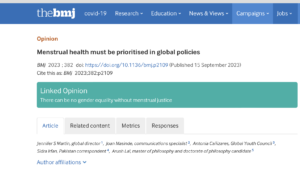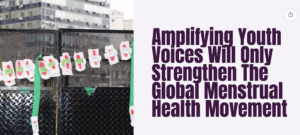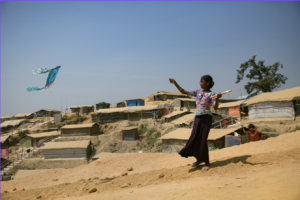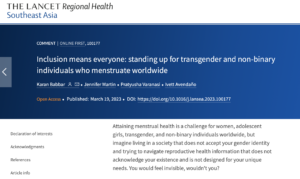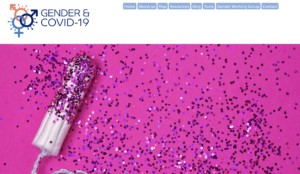As we approach the 2023 UN Climate Change Conference in Dubai, we must elevate the challenges that the climate crisis will have on women, adolescent girls, and people who menstruate. The climate crisis is not “gender neutral”. Women and girls experience the impacts of climate change the greatest, which exacerbates existing gender inequalities and poses unique threats not only to their health but also to their livelihoods, well-being, and safety.
The gendered effects of climate change are seen through the intersection of menstruation and climate change. Though it may seem unexpected, delving deeper into this issue reveals a complex web of connections between climate change and menstruation that affect vulnerable communities, exacerbating existing inequalities. Ranging from the accessibility of menstrual products and health risks due to the scarcity of water, the effects of climate change on menstrual well-being are extensive. In this blog post, we’ll explore the link between menstruation and climate change, how the latter can worsen period poverty; the regions at higher risk, and actionable steps to support the affected communities.
Exacerbating Period Poverty: Climate Change’s Role
Resource scarcity is a drastic consequence of climate change as extreme weather events disrupt supply chains. As a result, household incomes are restricted and “luxury” items such as period products are deprioritized. The disruption of supply chains and transportation networks leaves menstruating individuals without access to affordable menstrual hygiene products. Floods, hurricanes, and droughts can decimate production and distribution networks, leaving women and girls in vulnerable communities to grapple with managing their menstruation without the necessary resources.
Sanitation systems are also vulnerable to climate change-induced natural disasters. The damage inflicted by events such as floods and hurricanes compromises infrastructure, leading to unhygienic conditions. Proper sanitation systems are just as critical to menstrual well-being as are period products, like pads and tampons. For communities already struggling with period poverty, the compromised sanitation facilities heighten health risks during menstruation, further entrenching the cycle of vulnerability. In contexts where clean water becomes scarce, the menstrual needs of women and adolescent girls might be overshadowed by other, seemingly more pressing, priorities.
Amplifying gender dynamics and menstrual stigma
Gender dynamics play a pivotal role in exacerbating the effects of climate change on period poverty. Gender roles can intensify under the stress of environmental challenges, leaving women and girls bearing the burden of its effects. These roles often dictate that men are the primary providers while women are caregivers, leading to unequal distribution of resources during environmental challenges. Women’s roles in agriculture, healthcare, and family caregiving intensify, and their access to education and economic opportunities may decrease.
Women often face a disproportionate share of caregiving responsibilities, including caring for family members during and after disasters. Gender norms can restrict their access to essential resources like land and water, particularly in situations of scarcity. Lack of access to clean water and sanitation facilities can affect women’s health, as they are responsible for maintaining family hygiene. During migration or displacement caused by environmental issues, women and girls are vulnerable to gender-based violence and exploitation, with limited access to support services. Traditional gender roles can also limit women’s participation in decision-making processes and hinder their ability to influence policies related to environmental adaptation and disaster preparedness. Economic impacts from climate-related issues can disproportionately affect women, who often engage in small-scale farming and lack access to resources for adapting to new agricultural practices. The disruption of daily life due to environmental challenges can lead girls to drop out of school, with long-term consequences for their education and economic prospects.
Regions at Risk: Vulnerability Amplified
While the impact of climate change is felt globally, certain regions are particularly susceptible to its effects and its exacerbation of rates of period poverty. Low- to middle-income (LMICs), often facing economic constraints and inadequate infrastructure, are most greatly impacted. These countries bear a dual threat of period poverty and climate change vulnerability. Island nations, situated on the frontline of rising sea levels and extreme weather events, face a particularly dire situation. In these regions, climate change can amplify period poverty due to the compounded challenges posed by resource scarcity and limited access to outside aid. The intersection of geographical vulnerability and gender-specific needs underscores the urgency of addressing these issues holistically. For example, the El Niño-induced drought in Mozambique resulted in a restricted availability of the absorbent plant typically utilised by women and girls during their menstrual cycles, along with a scarcity of clean water. These circumstances placed significant challenges on women’s ability to uphold proper menstrual hygiene.
The coastal areas of Bangladesh are susceptible to cyclones and rising sea levels. Research conducted in cyclone shelters in Bangladesh has indicated that women and girls do not have access to separate or hygienic washing facilities and adequate spaces to change menstrual pads. Meanwhile, in the rural villages of flood-prone Assam, India, women, and girls encounter numerous logistical challenges in managing their menstrual hygiene during floods. Relief camps and temporary shelters in Assam lack separate toilets and appropriate disposal systems for menstrual waste, and disaster management plans that prioritize gender-sensitive hygiene responses have not yet been implemented during flood events.
The effects of supply disruption disproportionately impact low- and middle-income countries (LMICs). Limited resources and fragile systems make it harder for individuals to manage menstruation effectively during environmental challenges, exacerbating their existing economic precarity. Rural communities also face heightened risks. Disruptions in transportation and supply chains can significantly affect the availability of menstrual products and proper sanitation facilities, leaving those who menstruate with fewer options during already challenging times.
Acting: Supporting Vulnerable Communities
Understanding the intricate link between menstrual health experiences, climate change, and period poverty is the first step toward creating meaningful change. By recognizing the not-so-hidden gendered impacts, we can develop strategies to support vulnerable communities.
Education and awareness within vulnerable communities also play a vital role in this endeavor. Raising awareness about the link between menstruation, climate change, and period poverty enables communities to understand their vulnerabilities and advocate for their needs. Education must also take place at the global stage, ensuring that climate actors see menstrual health as a cross-cutting issue and a critical part to gender-responsive climate action.
Educating individuals about sustainable practices can drive change at the grassroots level. It can also build health literacy, body autonomy, and self-efficacy, so they can make informed choices about menstrual products. Sustainable menstrual products, although they can initially be more costly, offer a practical solution with far-reaching benefits. Advocating for and supporting the use of options like reusable cloth pads, menstrual cups, and eco-friendly disposables reduces waste and lessens the environmental impact of conventional products.
These alternative options, require adequate water, sanitation, and hygiene (WASH) facilities to clean products as well as spaces to dry them, and are thus unreliable in settings impacted greatly by the climate crisis. However, those in high-income countries (HICs) with the means to use sustainable products can do so and in turn, reduce their environmental impact. Advocates in the menstrual health space should also call for corporations to address their unsustainable practices for producing period products.
Disaster preparedness tailored to the needs of menstruating individuals is crucial. Supporting initiatives prioritising these needs during emergencies ensures that vulnerable communities are not left behind in climate-related crises. A good example is the United Nations Population Fund’s (UNFPA) dignity kits, which ensure basic supplies during a crisis to maintain the health and dignity of women and girls. This also demands that donors prioritise menstrual health programming in low-resource, resource-scarce, and humanitarian settings. Without generating donor buy-in, innovative and reliable menstrual health programming can be difficult to co-develop, implement, and sustain.
Collaborating with local organisations can lead to context-specific solutions with are more culturally congruent and thus more reliable and effective. By working with those who understand the unique challenges faced by at-risk communities, we can design interventions that make a meaningful impact. Interventions focused on poverty alleviation that do not consider culture can recreate cycles of poverty.
Advocacy for policies that address the needs of vulnerable communities is a powerful tool. Pushing for policies that include gender-responsive climate change adaptation and disaster planning and management strategies can create systemic change, helping to break the cycle of vulnerability. Advocates can also engage with business leaders and others who can financially invest in menstrual health programming and menstrual health-informed climate change response.
Conclusion
The intricate connection between menstruation and climate change underscores how global inequalities intersect in complex ways. By understanding and actively addressing this intersection, we can take significant steps towards fostering a world that is both inclusive and sustainable. Raising awareness, imparting education, involving local communities, and strategically acting upon this understanding enables us to disrupt the cycle of period poverty intensified by climate change. In doing so, we can pave the way for enduring, positive change that benefits the most vulnerable among us.


